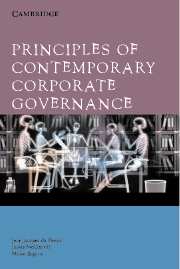Book contents
- Frontmatter
- Contents
- Table of cases
- Table of statutes
- Preface
- PART ONE CORPORATE GOVERNANCE: AN OVERVIEW
- PART TWO CORPORATE GOVERNANCE IN AUSTRALIA
- PART THREE CORPORATE GOVERNANCE IN PRACTICE
- PART FOUR CORPORATE GOVERNANCE: AN INTERNATIONAL PERSPECTIVE
- PART FIVE CORPORATE GOVERNANCE: GOING FORWARD
- 13 The case for enhanced shareholder participation in corporate decision-making
- 14 The ethical obligations of corporations
- 15 Reflections on contemporary corporate governance and its future direction
- Index
15 - Reflections on contemporary corporate governance and its future direction
- Frontmatter
- Contents
- Table of cases
- Table of statutes
- Preface
- PART ONE CORPORATE GOVERNANCE: AN OVERVIEW
- PART TWO CORPORATE GOVERNANCE IN AUSTRALIA
- PART THREE CORPORATE GOVERNANCE IN PRACTICE
- PART FOUR CORPORATE GOVERNANCE: AN INTERNATIONAL PERSPECTIVE
- PART FIVE CORPORATE GOVERNANCE: GOING FORWARD
- 13 The case for enhanced shareholder participation in corporate decision-making
- 14 The ethical obligations of corporations
- 15 Reflections on contemporary corporate governance and its future direction
- Index
Summary
… ethics and norms are not only more potent means to achieve compliance with the law than deterrence is, but in fact also delimit the relevance of deterrence.
Michael Wenzel, ‘The Social Side of Sanctions: Personal and Social Norms as Moderators of Deterrence’ (2004) 28 Law and Human Behavior 547, 549.Introduction
This chapter builds on the discussion in Chapters 5 and 6 of this book, which dealt with how corporate governance is regulated in Australia (both the sources of regulation, and the regulatory bodies), and introduced the so-called ‘pyramid’ of regulation developed by Ian Ayres and John Braithwaite in their 1992 book, Responsive Regulation. Reflecting on this material, in this chapter we make reference to a variety of sources of research (both in law and management), many of which are cutting edge, to identify recent and historical trends in the context of corporate governance regulation, and determine where regulation of corporate governance should be directed in the future. In this chapter, when discussing the ‘regulation of corporate governance’, in the Australian context we mean the ASX Principles of Good Corporate Governance and Best Practice Recommendations and the various formal corporate governance benchmarks now contained in the Corporations Act – mainly as a result of CLERP 9. We do not include other areas of law, for example taxation law, which may impact on the governance practices of companies.
- Type
- Chapter
- Information
- Principles of Contemporary Corporate Governance , pp. 363 - 386Publisher: Cambridge University PressPrint publication year: 2005

